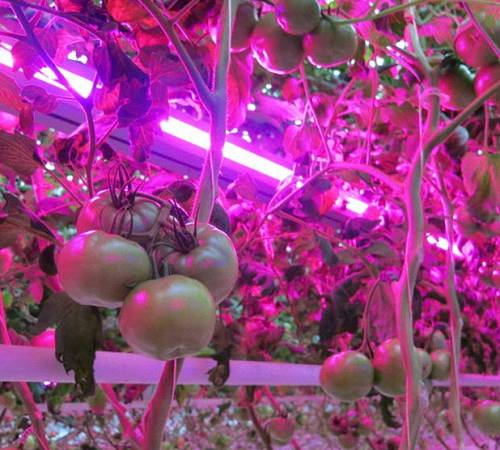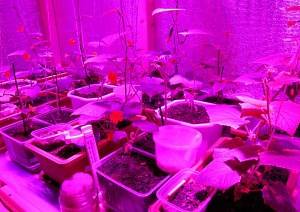Content
Seedlings are grown in early spring when daylight hours are still short. Artificial lighting solves the problem of lack of light, but not every lamp is equally useful. For plants, parameters such as intensity and spectrum are important. The optimal solution is to illuminate the seedlings with an LED strip, collected by yourself in a few minutes.
The benefits of artificial lighting
Lack of light negatively affects the development of seedlings. In plants, photosynthesis is inhibited, leaves and stems begin to fade. Vegetable growers solve the problem by installing artificial lighting from lamps. A yellow or white glow has a positive effect on the process of photosynthesis, but does not bring other benefits. The entire necessary spectrum contains sunlight, which promotes the development of cells, leaf plates, and the formation of inflorescences. The illumination of seedlings with LED strips of different luminescence allows you to get as close to the indicator as possible.
LEDs emit the spectrum that the seedlings need in natural light. Scattered rays are better captured by plants. To obtain them, reflectors are installed from mirrors or foil. Of the entire emitted spectrum, three colors are especially useful for seedlings:
- blue - stimulates growth;
- red - accelerates the formation of inflorescences;
- pink - combines the useful features of blue and red.
To get the full spectrum, they began to use strips to illuminate seedlings from LEDs of different luminescence.
In the video, the illumination of seedlings with LED strip:
Pros of using LED strips

LEDs have the main advantage - they emit the spectrum of light necessary for seedlings, but there are also a number of important advantages:
- the tape consumes little electricity;
- LEDs emit light waves of different lengths, which are better absorbed by plants;
- the tape is designed for a long service life;
- low voltage operation makes the LED strip fire and electrical safe;
- LEDs have minimal flicker, no UV and IR radiation;
- LEDs are environmentally friendly due to the absence of harmful substances such as mercury.
The downside is cost. The price of a good LED strip with a power supply is 7-10 times higher compared to a cheap LED bulb, but the backlight will pay off in a couple of years.
Lighting installation rules

The lighting for seedlings on the windowsill is equipped with an LED strip so as to maximally exclude moisture from entering the electrical part. Light sources are attached above the plants. You can glue the glowing strip to the back of the shelf on the top tier of the rack. Reflectors are placed on the sides of the seedling box. In this position, the mirror surface diffuses light better.
Advice! It makes no sense to place a reflector on top of the seedlings next to the light source. LEDs emit a directed beam of light, in this case downward. The rays will not hit the reflector and it will be simply useless.
When growing a large number of seedlings, make large racks with five shelves and place them on the floor. The remoteness of the structure from the window requires an increase in the illumination time. So that the LEDs do not overheat from long-term operation, the tapes are glued to the aluminum profile.
If the illumination is fixed to the back side of the shelf of the upper tier of the rack, then the possibility of adjusting the height of the illumination is excluded. The light source should be located above the seedlings with a gap of 10 to 40 cm. LEDs practically do not emit heat. The risk of foliage burns is excluded, and this allows you to set the optimal gap - 10 cm.
When pecking the shoots, the lighting device must be brought as close as possible to the boxes. The seedlings grow vigorously, and with it the raising of the light source is required to maintain the gap. For this reason, it is better not to firmly fix the LED strip to the shelves of the rack, but to make a separate lamp from an aluminum profile or a wooden bar. A home-made lighting device is fixed with ropes to the lintels of the rack and, if necessary, is lowered or raised.
Choosing a strip for backlighting
Many vegetable growers are scared not by the cost of the LED strip, but by the lack of experience in choosing and connecting it. There is nothing difficult in this. Now we will look at how to choose an LED strip for illuminating seedlings and what other details are required.
All tapes are sold in lengths of 5 m, wound on a roll. It will have to be cut to the size of the shelves of the rack, and the pieces will have to be connected with wires. Aluminum rulers with soldered LEDs are an alternative. The metal base serves as a cooler. The rulers are produced in different lengths and it is easier to choose them for the size of the rack, but the cost of the product is slightly more expensive than the tape.
When buying an LED strip, they look at the following characteristics:

Important! There is an IP mark on the product packaging. This is the indicated degree of protection. When determining which LED strip is best for illuminating seedlings, preference is given to a product with a high IP value. The LEDs have a silicone coating that protects against moisture and mechanical damage.
It is optimal to choose a product with a number of LEDs 5630, a power of 20 W / m and a glow angle of 120 ° for illuminating seedlings.
An important indicator is the power of the LEDs. The higher the value, the more heating occurs. For heat dissipation, aluminum profiles are sold. When making a homemade backlight, you should not save on this element.
The ribbons are sold in different colors. For plants, it is optimal to use two colors: blue and red. If the seedlings are in the room, such lighting creates discomfort for vision. The optimal solution to the problem would be to manufacture a luminaire with warm white LEDs.
LEDs operate on direct current with a voltage of 12 or 24 volts. Connection to the outlet is via the power supply. In terms of power, the rectifier is selected with a margin. If you take it back to back, then the electronic device will quickly fail from overheating. For example, the power of 5 m of tape is 100 watts. A 120-150 W power supply will do. More is better than less.
Assembling the LED backlight

To make a lamp, you need a strip equal to the length of the shelf of the seedling rack. You can use a wooden beam, but it is better to buy an aluminum profile. It will be neater, plus the side walls will act as a cooler.
If white LEDs are selected for illumination, one luminous strip is enough above the shelf with seedlings. With a combination of red and blue LEDs, a lamp is made of two strips. For pairing, aluminum profiles are screwed to a wooden strip parallel to each other with self-tapping screws.
Attention! In a combined luminaire, the ratio of LEDs is adhered to: for 1 red light bulb, there are 8 blue light bulbs. You can achieve approximately the same result if you buy a red ribbon with a minimum number of bulbs per 1 m and a blue ribbon with a maximum number of bulbs per 1 m.
The LED strip is cut to the length of the profile. The location of the cut can be easily identified by the scissor pattern applied. Two wires are soldered to one end or a connecting connector is installed. On the back of the LEDs there is an adhesive layer covered with a protective film. You need to remove it and stick the tape on the aluminum profile.

The lamp is ready. Now it remains to connect the LED strip for illuminating the seedlings to the power supply. The LEDs will light up if the polarity is correct: plus and minus. Phase and zero markings are printed on the power supply. There are “+” and “-” marks on the tape at the place where the wires are soldered. The wire coming from the minus is connected to the zero contact on the power supply, and the positive wire to the phase contact. If connected correctly, after applying voltage, the homemade lamp will light up.
Attention! There are multi-colored RGB LED strips with 4 connection wires. They are not suitable for highlighting seedlings. It makes no sense to spend extra money and assemble a complex circuit with a controller.
The video demonstrates the manufacture of the lamp:
Luminaires are made in the same way as the number of shelving shelves. A homemade lighting fixture is suspended from a rope above the seedlings. With the growth of plants, the lamp is raised higher, maintaining a gap of at least 10 cm.



